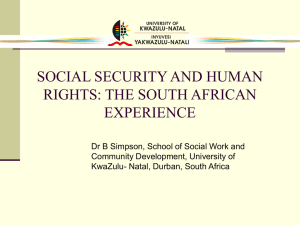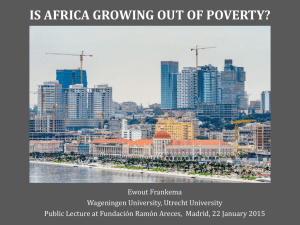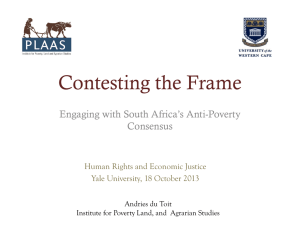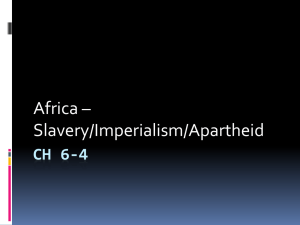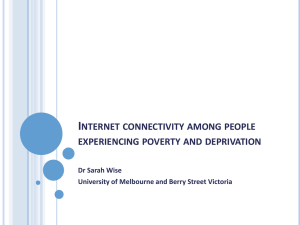In search of the good society - Human Sciences Research Council
advertisement
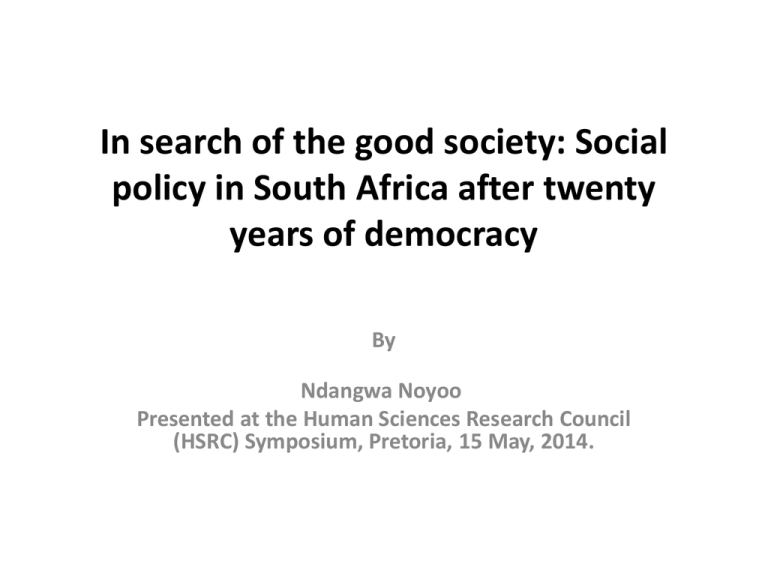
In search of the good society: Social policy in South Africa after twenty years of democracy By Ndangwa Noyoo Presented at the Human Sciences Research Council (HSRC) Symposium, Pretoria, 15 May, 2014. Introduction Last year, the Minister in the Presidency responsible for the National Planning Commission, Trevor Manuel, noted at a function: “We (government) should no longer say it is apartheid’s fault…in 1994, 1995, and 1996, government could perhaps have said we do not have the experience, but as the country approached two decades of democracy this was no longer an excuse.” 2 At another public gathering, president Jacob Zuma, responded to Manuel’s assertions in the following manner: “The legacy of apartheid runs too deep and too far back for the democratic administration to reverse it in so short a period.” Both Manuel’s and Zuma’s sentiments were made in reference to the pace of transformation in the country. This presentation takes both views as having some merit. 3 Indeed, a lot of work has been done in order to transform the lives of ordinary South Africans since 1994. Nevertheless, the majority of citizens still wallow in abject poverty; are mostly unemployed, destitute and living in squalid conditions. 4 Key questions Could things have been done any better? Were there any missed opportunities? If so, could they have significantly blunted the transformation process? 5 Point of departure There were some missed opportunities that emanated from the manner in which social policy was developed and implemented since 1994. Arguably, social policy was more of a technocratic and bureaucratic task as opposed to being a vehicle for the creation of the good society. If social policy was couched in the discourse of the good society, most probably, a much deepened and expansive social and human development process would have ensued. 6 This would also have allowed for the “reengineering” of the South African society. Notably, true and profound transformation must be underpinned by concerted efforts, by the state, to “socially re-engineer” the South African society, given the fact that apartheid was in itself a pernicious form of “social engineering” and whose outcomes we are still grappling with 20 years after its demise. 7 The best tool, to effect the aforementioned, is social policy, which is philosophically tilted towards the creation of the good society and not one that is just a technocratic and bureaucratic task or one that is meant to stave off economic and labour-market failure. This approach to social policy also resonates with the ANC’s historical mission of liberating the mass of the people from colonialism and apartheid. 8 Crucially, the proposed approach to social policy is in line with the tenets of the National Development Plan (NDP) and its thrust of building the capabilities of both the state and citizens. It is also one that endorses the NDP’s quest for active citizenry as opposed to passive citizenry. 9 Historical backdrop and conceptual premise The key concepts in this presentation are: (i) Social policy and (ii) the good society. The development of social policy is linked to Britain, especially to the rise of the Fabian Society and the influence of Fabian politics on policy development in Britain. The Fabian Society was established in 1884, and was strongly influenced by the work of Sidney Webb. 10 Early Fabian social policy thinking also drew on new research evidence emerging from some of the earliest empirical studies of social problems in the country by Charles Booth and B. Seebohm Rowntree, whose research revealed that the extent and depth of poverty in Britain at the end of the nineteenth century were both serious and widespread. This challenged conservative political assumptions that economic markets could meet the welfare needs of all; and the Fabians used it to argue that policy intervention through the state was needed to provide those forms of support and protection which markets could not (Alcock, 2008). 11 Subsequently, the London School of Economics (LSE) established a new Department of Social Sciences and Administration, in 1912, to pursue social policy as an academic discipline (Alcock, 2008). In many respects the discipline of social policy is also strongly linked to the rise of the Welfare State in Western Europe, especially in the aftermath of the Second World War. Since then there have been changes and alterations in these societies and their systems in significant ways. 12 Due to its imperial past, Britain bequeathed its institutions, social mores, forms of governance and so forth, to most of the developing world and Africa, in particular. Social policy initiatives in Africa, at least of a formal type, emerged during the colonial period and were later on, wittingly or unwittingly, reinforced by various African countries after they became independent. 13 In South Africa, the development of social policy is deeply rooted in the history of colonial conquest and occupation. In this sense, its genesis is directly linked to the initial annexation of the Cape peninsula and eventual subjugation of indigenous peoples by a European Dutch settler population. The rise of the so-called poor “white problem” as firstly noted at a Dutch Reformed Church Synod in 1886, would pave the way for religious and state-led interventions aimed at mitigating white poverty. 14 The industrialisation of South Africa, which immediately came on the back of the discovery of vast mineral deposits of diamonds and gold (and also led to the dismantling of the indigenous economies and erosion of the Afrikaners’ livelihoods) culminated in government social policy interventions - especially after General Hertzog came into power in 1924. The Carnegie Corporation of New York, which was persuaded to fund a new approach to white indigence: a scientific investigation into the causes of white poverty, its extent, and the means by which it could be reduced - at the instigation of the Dutch Reformed Church in 1928 - also played a key role here (McKendrick, 1987). 15 However, social policy was expressed tangibly as social assistance and to a lesser extent, social insurance on the one hand, and residual social welfare, on the other. This legacy still influences present-day social policy discourse. However, the situation was not so different to areas under British rule in Africa where social policy was defined by social welfare and community development programmes. However, the racial dimension was more pronounced in South Africa. 16 Social policy and the post-colonial state The post-colonial state would be created against a backdrop of dispossession, oppression and socio-economic exclusion of the indigenous peoples. After independence, several African leaders attempted to redeem some of the positive features of pre-colonial state formation. 17 The genesis of post-colonial African social policy must be located in the post-Second World War anti-colonial struggles which were spearheaded by various nationalist movements on the continent. Once these countries had attained independence, some of them tried to redesign colonial social policies so that they responded to the majority who were poor, vulnerable and residing mostly in the rural areas. 18 Hence, most African states were, not surprisingly, invested with broad-ranging social responsibilities which were integral to the anti-colonial social contract on the basis of which the nationalist politicians mobilised the populace for the independence struggle. Central to the contract was the promise of the expansion of social policy in a direction which would significantly improve the health and nutritional status of the populace, expand access to education and offer greater opportunities for employment (Olukoshi, 2004:2-3). A radical redress of the inherited colonial structural impediments in the political economy was sought after. 19 In Ghana, Tanzania and Zambia, for example, a pan-African and African socialist ideology had paved the development paths of these countries and ultimately defined their social policy choices. Social policy was not only seen as a nationbuilding vehicle but it was extended to the liberation struggle, and in the case of Zambia, the emancipation of Southern African countries from white minority rule (Noyoo, 2010). 20 Therefore, the term social policy involves two aspects: First, it refers to the actual policies and programmes of governments that affect people’s welfare. Second, it connotes an academic field of inquiry concerned with the description, explanation and evaluation of policies. Of the different ways of influencing human wellbeing through social policy, the direct method is the most common (Midgley, et al., 2000). 21 There are three direct mechanisms by which governments seek to promote the welfare of human beings: (a) through the introduction of social services such as education, housing, income security and family, and community welfare; (b) through the use of statutory regulation, for instance, enacting of legislation that mandates employers, homeowners, educational institutions, commercials firms, and many others to adopt measures that have a direct impact on human well-being; and (c) through the tax system (Midgley, et al., 2000). 22 Social policy is only meaningful if we (society, a group, or an organisation) believe we can affect change in some form or other. The word “policy” is used here in an action-oriented and problemsolving sense (Titmuss, 1974). In this regard social policy should not be deemed as inherently “good” as it can be perverted by illegitimate and uncaring regimes, for purposes of only shoring up the interests of certain classes at the expense of the whole society. 23 For this discussion, social policy fulfils three main functions in any society namely: social, political and economic. The social function lies in reducing the impact of life cycle risks through social insurance and alleviating poverty through social assistance. It helps people to stabilise their lives and support their families. The political function lies in its stabilising effect. Social justice and greater equality are vital factors for building trust and social cohesion, and contribute to political stability. 24 Finally, the economic function of social policy lies primarily in widening the productive capacity of a society through the inclusion of marginalised areas and social groups in the growth process, and through investment in improved health and education. (Economic and Social Commission for Western Asia, 2009). 25 It is clear, especially in this millennium, that there is a need for comprehensive and transformative social policies which address a multiplicity of objectives that include equity, social inclusion, and human capital formation. In order to achieve the foregoing, a multidisciplinary approach, which incorporates social, economic, cultural and environmental aspects of development is crucial. Hence, a broad framework for formulating social policy, namely (a) reducing disparities and (b) managing risks and challenges, is recommended. 26 However, a country’s social policy should be a natural product of its markets, communities and households and should be formulated in the context of that country’s traditions, institutions, culture and values as well as the availability of financial resources. National efforts must also be complemented by various forms of regional, cross-border cooperation that could serve as a stepping stone to a socially just globalisation. 27 Unpacking the notion of the good society The question to ask here is: what kind of state would be amenable to establishing the good society? Indeed, the state has the responsibility to advance the common good rather than the good of some or a few. The nature of the state may however be determined by its other characteristics e.g. whether it will be a negative state responsible only for maintaining law and order or a positive one which removes those obstacles such as poverty, illiteracy and poor working conditions that stand in the way of the full (social and moral) development of the individual within society (Olowu, 1994). 28 This presentation takes a leaf from Ancient Greek Philosophers, such as Aristotle, who posited the unity of politics and ethics, i.e., political actions must help to sculpt the good society. Also, citizens of the good society must have a lifestyle that is consistent with and conducive to virtue and that allows for the expression of virtue. 29 Twentieth century scholars such as Lippmann (1937) point out that when we delve into debates of the good society, we (that is those who accept that the good society is indeed attainable) have to first and foremost accept that freedom is a cornerstone of the good society. What this means is that a prosperous and peaceful society must be free. If it is not free, it cannot be prosperous and peaceful. 30 Modern scholars such as Galbraith (1996) take the view that the good society is the achievable society and also accept that some barriers to achievement are immobile, decisive and must be accepted. But there are goals that cannot be compromised. 31 In the good society all of its citizens must have personal liberty, basic well-being, racial and ethnic equality, and the opportunity for a rewarding life. Moreover, a good society must have a good economy. An evident purpose of a good economy is to produce goods and services effectively and to dispense the revenues therefrom in a socially acceptable manner. It must have substantial and reliable increase in production and employment from year to year. 32 Deconstructing and redefining the post-1994 transformation agenda It is a fact that the pillars of colonial-apartheid capitalism are still intact and the economic base is still attuned to the past dispensation as opposed to the present one – of a liberated South Africa. For example, recruitment of labour, especially in the mining sector, is still predicated on an outmoded migrant labour system. 33 Critically, policy instruments and services thereof mostly lacked emancipatory and capability-building properties that could have “re-engineered” SA . Probably, the assumption was that once services were “delivered” then all would be well. But the various service delivery protests seem to have dispelled this notion. 34 Also, South Africa’s political economy is influenced by the heavy presence of the mineral-extractive industry. Despite concerted efforts to expand the production base after 1994, economic activity continues to be locked into either extraction of minerals or other raw materials – just like the rest of sub-Saharan Africa. Thus, the Minerals Energy Complex (MEC) is centrally located at the core of the South African economy, not only by virtue of its weight in economic activity, but also through its determining role throughout the rest of the economy (Fine and Rustomjee, 1996). 35 Paradox or reality? The paradox here is that the South African government has deployed a lot financial resources into the social sector in order to raise the quality of life of the citizens. E.g. the country’s elaborate social assistance programme, with slightly over 16 million beneficiaries disburses: the old age grant, war veterans’ grant, disability grant, foster care grant, care dependency grant and the child support grant (CSG). The largest numbers of beneficiaries are on the child support grant. The number of child support grant beneficiaries has risen from 5.7 million in 2004/05 to about 11.4 million as a result of the increase in the eligibility age to a child’s 18thbirthday (National Treasury, 2013). 36 Furthermore, the government contributes to reducing the cost of living in three ways: i. Investment in the social wage, comprising education, health services; ii. social development, public transport, housing and local amenities; and iii. Contributory social security, including unemployment insurance, injury compensation and death or disability benefits. 37 Agenda-setting: re-engineering South Africa via social policy Given the foregoing why are the vestiges of apartheid still firmly in place in certain respects? For instance high inequality and poverty levels, apartheid spatial development patterns, extreme wealth in the hands of the white population, high unemployment levels, among others. Social policy interventions can ill afford to eschew philosophical or ideological positions, strong planning perspectives and historical analyses – to some extent, this has been the case in the last 20 years. 38 I. Bridging the divide between the NDP and social policy forays Thankfully the NDP has already been in existence since 2011 and has been adopted by the government. Thus, social policy and planning needs to be the next phase in social policy interventions. More planning efforts are needed in the social policy arena. The NDP should be the beacon for social policy and planning endeavours. 39 II. Building the capabilities of beneficiaries of social grants In line with the NDP’s thrust, social policy programmes should aim at building the capabilities of the beneficiaries of social grants. How can this transpire? (a) Through high quality and universal Early Childhood Development (ECD) services, beginning with the most remote and impoverished rural areas and working up from village levels to the urban areas. * All children on the CSG need to be tracked and monitored through-out the years at ECD centres. The youths who were trained in programmes like masupatsela can play a critical role here. 40 (b) High quality and universal primary and secondary education: All children on the CSG would again be eligible for this education (notwithstanding the no fees schools since 2007). Social policy that is driven by planning would bring in all the social service professionals to track, monitor and case-manage the development of these children – so as to deal with issues of drop-out, emotional stability and support, and intellectual competencies. 41 (c) Charting the school-to-tertiary transition by: availing the former CSG beneficiaries to study either in Cuba, South African universities, colleges, free of charge but bonded to government for at least three years. In those three years, they will be expected to work in rural communities in hospitals, etc. “Ring-fencing” a population on the CSG from 0-24 years, thereabout, would allow the government to create a whole new group of South Africans (who were previously disadvantaged). After 24 years they would be educated, highly skilled and contributing tax which would again be used to invest in the foregoing – thus becoming a virtuous cycle. 42 Mainstreaming the mothers or care givers of children on the CSG into the economy (d) Building the capabilities of mothers or caregivers of the children on the CSG through “ringfenced” government procurement mechanisms (after ample training and start-up capital) in the areas of: School feeding schemes, cleaning of government offices, laundry services at government institutions such as prisons, hospitals, etc., or making uniforms for prisoners, etc. These women would be the service providers and not private companies. The conditionality here would be that the women formed co-operatives and also played a key role in the education of their children. 43 Conclusion One way of ensuring that the good society comes to pass is by having social policy that drives a well-mapped out process of “social reengineering” that is underpinned by judicious planning and philosophical/ideological positions. The good society is achievable in South Africa with an ANC-led government if it sticks to its historical mission that it embarked upon in 1912. 44 The presentation used practical examples relating to how the social assistance programme could move beyond just staving off abject poverty to becoming more developmental by building the capabilities of the beneficiaries. The examples were not exhaustive, for instance, there are other areas such as modernising and stabilising labour as a key social policy imperative, among others. 45 References Alcock, P. (2008). The subject of social policy. In P. Alcock, M. May & K. Rowlingson (Eds.), The Student’s Companion to Social Policy. (pp. 1-10). Malden: Blackwell Publishing. Economic and Social Commission for Western Asia, (ESCW). (2009). Social Policy and Social Protection. http://www.escwa.un.org/information/publications/edit/upload/sdd-09-TP10.pdf, (Retrieved 27 July 2011). Fine, B., & Rustomjee, Z. (1996). The Political Economy of South Africa. London: C. Hurst & Co. (Publishers) Ltd. Lippmann, W. (1937). An inquiry into the principles of the good society. Boston: Little, Brown and Company. Galbraith, K. (1996). The Good Society: The Human Agenda. New York: Houghton Mifflin Company. McKendrick, B.W. (Ed.) (1987). Introduction to Social Work in South Africa. Pretoria: HAUM. Midgley, J., Tracy, M.B., & Livermore, M. (2000). Introduction. In J. Midgley, M.B. Tracy & M. Livermore (Eds.), The Handbook of Social Policy. (pp.3-10). Thousand Oaks: SAGE Publications. Noyoo, N. (2010). Social Policy and Human Development in Zambia. London: Adonis & Abbey. Olukoshi, A. (2004). Neo-liberal Globalisation and Its Social Consequences. http://www.pambazuka.org/en/publications/africanvoices_chap01.pdf, (Retrieved 15 October 2013). Olowu, D. (1994). The nature and character of the African state. Paper presented for the African Association for Public Administration and Management (AAPAM) 15th Roundtable, Banjul, Gambia. Titmuss, R.M. (1974). Social Policy: An Introduction. London: Allen and Unwin. 46
